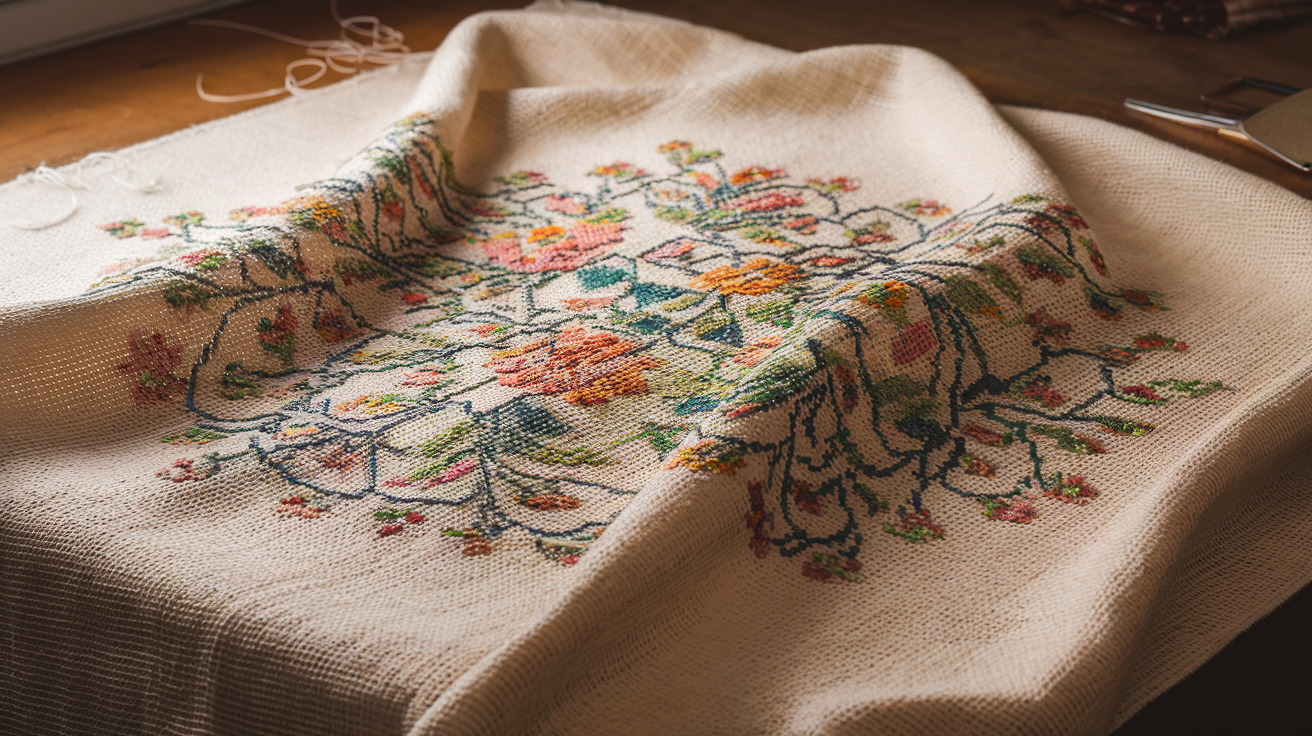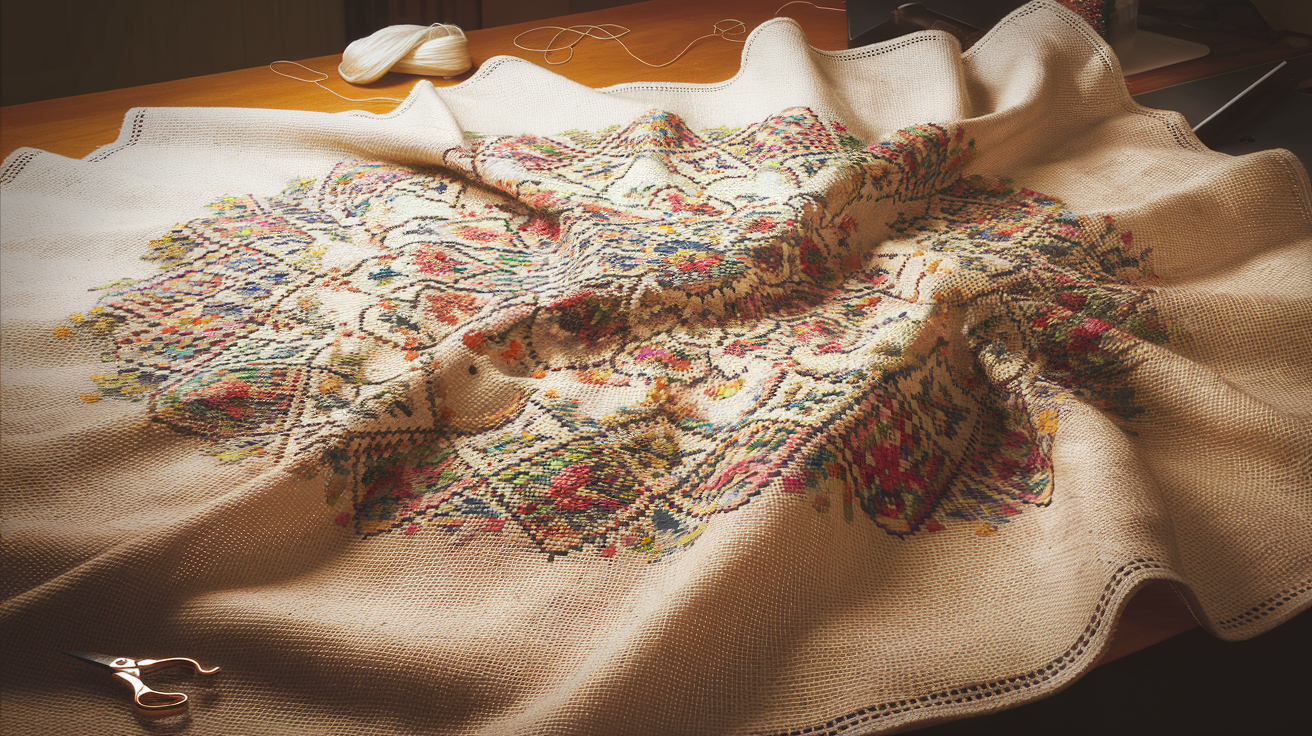How To Manage Large Cross Stitch Fabric For Big Projects

Managing large cross stitch fabric for extensive projects requires careful planning and key techniques to keep the process organized, your fabric undamaged, and your stitching enjoyable. Handling large cross stitch projects presents unique challenges: measuring and cutting fabric precisely, ensuring adequate margins, preventing fraying, and controlling excess material.
Practical workspace organization and preventative care protect your progress and facilitate a smoother experience, from setup to finishing.
For crafting supplies, remember that these are important tools.
Next, explore step-by-step fabric preparation for sizable canvases to ensure lasting quality and comfort during your cross stitch journey.
Fabric Preparation for Sizable Canvases
Fabric preparation directly impacts the quality of your cross stitch project, especially for sizable canvases that demand precision.
Begin by pre-washing your cross stitch fabric to accommodate shrinkage and preserve fabric cleanliness before embarking on sectional stitching. Pre-marking registration marks with a water-soluble pen ensures pattern scaling accuracy and reliable alignment throughout your stitching workflow.
Establish a clear, ergonomic crafting space to facilitate creative process and hobby efficiency; a stable mounting surface or embroidery frames will help maintain consistent stitch tension.
For enhanced textile security, finish fabric edges with whip stitching or serging, supporting both fabric fraying prevention and material preservation.
This attention to detail helps with textile handling, ensuring stitch clarity and tactile comfort.
Securing fabric properly contributes significantly to the overall stitch quality during these lengthy endeavors.
Edge Finishing for Textile Durability
To prevent unravelling throughout the lengthy stitching process, ensure fabric edges are finished. Using techniques like whip stitching, serging, or even fabric glue and tape will provide essential fabric fraying prevention.
This step is particularly important for linen care and evenweave handling, safeguarding your sizable canvases.
Proper finishing also aids in maintaining material preservation, keeping your project pristine.
Workspace Organization for Crafting Workflow
Maintaining a clean and organized workspace is key for hobby efficiency. Adequate lighting conditions and stable surfaces contribute to ergonomic crafting, reducing discomfort during prolonged sessions.
This also aids in keeping your fabric clean and free from accidental damage. A well-organized space supports a better crafting workflow, making your creative process more enjoyable.
Frame and Hoop Management for Tension Control
Choosing the right frame or hoop is essential for managing large projects.
For substantial pieces, scroll frames, large Q-snap frames, or sturdy hoops help keep tension even and free up workspace.
Proper hoop management ensures consistent stitch tension, which is important for stitch clarity and preventing puckering. Scroll frame use and Q-snap alternatives can all improve textile handling for ambitious undertakings.
Managing Excess Fabric and Maintaining Cleanliness
Organizing excess fabric by gently rolling, folding, or securing it with devices like a grime guard, clips, or even a pillowcase is important. This keeps your workspace tidy and your stitches clean from dirt and oils, helping with fabric cleanliness.
Keeping fabric clean involves frequently washing your hands and using these accessories.
Proper excess fabric control prevents accidental stitching through multiple layers, contributing to material preservation.
Think about fabric storage solutions like project bags for your needlework accessories.
Pattern Sectioning and Stitch Counting
Breaking up large patterns into smaller sections or quadrants makes them less overwhelming and helps track progress more easily.
This sectional approach assists with stitch counting and ensures pattern accuracy, especially with design complexity and intricate details. It’s a smart technique for tackling elaborate designs.
The Parking Method for Thread Management
The parking method is a useful technique for managing multiple thread colors when stitching dense or detailed designs.
This crafting technique can simplify the process of working on intricate details, contributing to better stitch control and less frustration for the hobbyist guidance.
Regular Inspection and Stitch Care
Regularly check your stitching area for wrinkling, tension issues, or accidentally catching excess fabric on the back. Periodically inspect stitching for puckering or tension problems, especially after moving frames or rolling fabric.
Reposition your hoop or frame carefully and avoid placing it over completed stitches to prevent crushing them; plump squished stitches with a gentle wash when finished. This meticulous approach ensures stitch quality and proper textile finishing for your largescale embroidery.

How to Cut Cross Stitch Fabric Accurately
Embarking on any sizable canvases begins with meticulous planning, and for cross stitch fabric, precise cutting is paramount. To preserve warp and weft integrity, measure precisely before cutting your chosen material.
For crisp edges that enhance textile finishing and prevent accidental distortion, employ a sharp rotary cutter used in conjunction with a self-healing mat, a staple for any crafting workflow.
When considering your design, cut slightly larger than needed; this provides essential flexibility for framing adjustments or potential sectional stitching on elaborate designs.
Should fabric fraying prevention be a concern, reinforce the fabric edges with fabric glue or a specialized fray-stopping product to ensure textile security for ambitious undertakings.
Managing Stitching Margins Effectively
For substantial pieces, allocate generous margin allowances—typically 2-3 inches—for framing and finishing purposes, ensuring ample material for handling and error correction.
Clearly marking these lines on the fabric with a water-soluble pen or a light pencil aids in straightforward adjustments as your creative process unfolds. Experiment with different margin sizes based on your preferred finishing method, whether you opt for a Qsnap frame, a scroll frame, or another hoop management system, to ensure adequate material.
This careful consideration supports overall large project management and simplifies the journey through meticulous stitching.
- Precise measurement before cutting cross stitch fabric is crucial for preserving warp and weft integrity.
- Using a sharp rotary cutter with a self-healing mat ensures crisp edges and prevents distortion.
- Cutting fabric slightly larger than needed offers flexibility for framing and potential sectional stitching.
- Allocating generous margin allowances (2-3 inches) is recommended for framing, finishing, and error correction on substantial pieces.
Securing Fabric for Large Projects
Properly mounting your cross stitch fabric is fundamental for a successful experience when undertaking lengthy endeavors or large project management. Utilizing specific tools helps maintain consistent stitch tension across sizable canvases, allowing for a more enjoyable creative process.
Ensuring your fabric is secure and flat prevents design complexity issues and allows for precise stitch counting.
Essential Tools for Tension Control
When managing cross stitch fabric for an ambitious undertaking, selecting the right support system is paramount.
Scroll frames offer extensive support, allowing for easy rolling and adjustment of the fabric.
Large Q-snaps provide firm, even tension across a larger area than traditional hoops, preventing puckering on substantial pieces. Sturdy hoops, particularly larger sizes, remain a reliable option for maintaining stitch clarity and fabric support throughout the stitching process.
Managing Excess Fabric and Workspace Tidy
For optimal results with any textile arts project, controlling excess fabric is key to maintaining a clean and organized workspace.
Fabric preparation for extensive projects involves more than just securing it; effective management of excess material prevents it from becoming a nuisance.
Utilizing a grime guard or even a simple fabric cover can shield the unstitched portions of your cross stitch fabric from hand oils and environmental dirt, contributing to overall fabric cleanliness. Gently rolling or folding this excess fabric and securing it out of the way ensures your workspace tidiness, allowing you to focus on the intricate details of your design without distraction.
This practice aids in excess fabric control and contributes to overall needlework organization.
Preventing Fraying and Maintaining Fabric Integrity
Fabric fraying prevention is a critical step in material preservation when working with sizable canvases or delicate weaves like linen care or evenweave handling.
Finishing the edges of your cross stitch fabric, whether through serging, whip stitching, or using a fray-stopping adhesive, safeguards against unraveling during the extended stitching process.
This meticulous attention to the fabric edges ensures the integrity of your material, especially for lengthy endeavors where constant handling occurs. Securely finished edges contribute to better textile handling and prevent issues that could compromise the final outcome of your elaborate designs.
Optimizing Your Crafting Environment
Creating an ergonomic crafting space enhances the overall hobbyist guidance for any project, especially larger ones.
Good lighting conditions are essential for precise stitch counting and reducing eye strain during long sessions. A stable surfaces for your frame or hoop prevents accidental shifts and supports a consistent stitch tension.
Regularly checking your stitching area for any signs of wrinkling or tension issues, particularly after repositioning your hoop management or adjusting your scroll frame use, ensures high-quality stitch clarity.
This mindful approach to your crafting workflow supports efficient hobby progress and better stitch quality, making even ambitious undertakings more manageable.
- Utilizing tools like scroll frames and large Q-snaps helps maintain consistent stitch tension across sizable cross stitch canvases.
- Managing excess fabric with a grime guard or fabric cover protects unstitched portions from oils and dirt, contributing to fabric cleanliness.
- Finishing fabric edges through methods like serging or whip stitching safeguards against unraveling during extended stitching processes.
- Good lighting conditions and stable surfaces are essential for precise stitch counting and preventing accidental shifts in your crafting environment.




